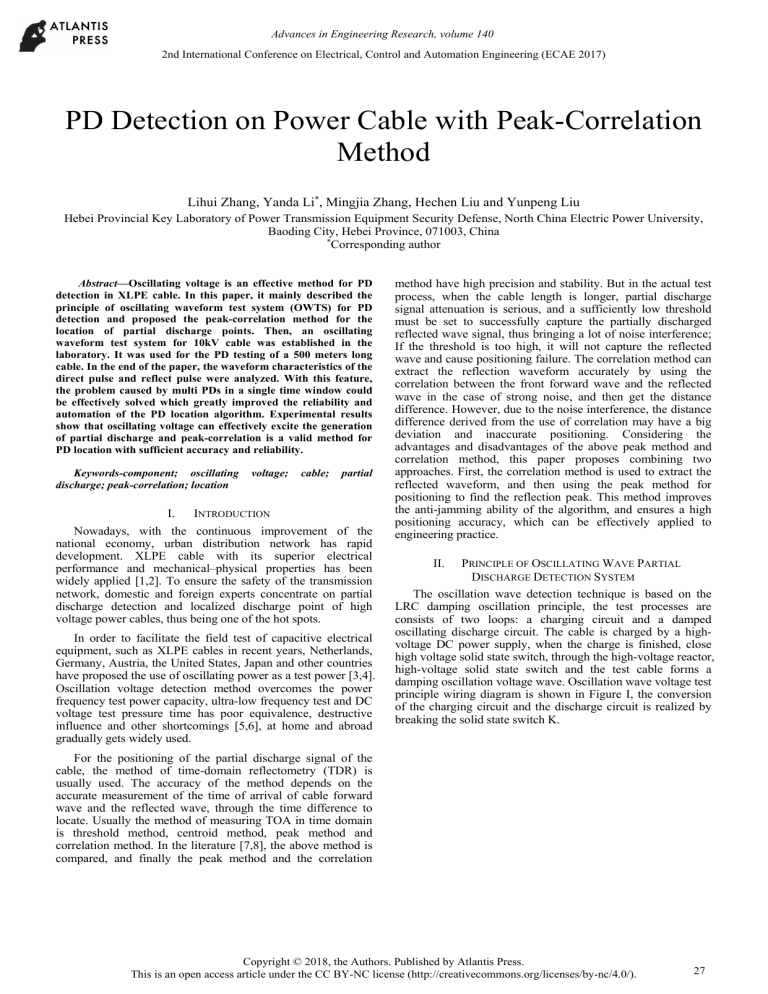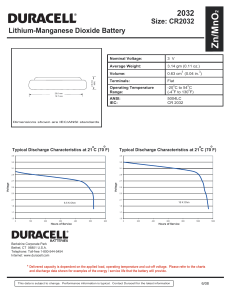
Advances in Engineering Research, volume 140
2nd International Conference on Electrical, Control and Automation Engineering (ECAE 2017)
PD Detection on Power Cable with Peak-Correlation
Method
Lihui Zhang, Yanda Li*, Mingjia Zhang, Hechen Liu and Yunpeng Liu
Hebei Provincial Key Laboratory of Power Transmission Equipment Security Defense, North China Electric Power University,
Baoding City, Hebei Province, 071003, China
*
Corresponding author
Abstract—Oscillating voltage is an effective method for PD
detection in XLPE cable. In this paper, it mainly described the
principle of oscillating waveform test system (OWTS) for PD
detection and proposed the peak-correlation method for the
location of partial discharge points. Then, an oscillating
waveform test system for 10kV cable was established in the
laboratory. It was used for the PD testing of a 500 meters long
cable. In the end of the paper, the waveform characteristics of the
direct pulse and reflect pulse were analyzed. With this feature,
the problem caused by multi PDs in a single time window could
be effectively solved which greatly improved the reliability and
automation of the PD location algorithm. Experimental results
show that oscillating voltage can effectively excite the generation
of partial discharge and peak-correlation is a valid method for
PD location with sufficient accuracy and reliability.
Keywords-component; oscillating
discharge; peak-correlation; location
I.
voltage;
cable;
partial
INTRODUCTION
Nowadays, with the continuous improvement of the
national economy, urban distribution network has rapid
development. XLPE cable with its superior electrical
performance and mechanical–physical properties has been
widely applied [1,2]. To ensure the safety of the transmission
network, domestic and foreign experts concentrate on partial
discharge detection and localized discharge point of high
voltage power cables, thus being one of the hot spots.
In order to facilitate the field test of capacitive electrical
equipment, such as XLPE cables in recent years, Netherlands,
Germany, Austria, the United States, Japan and other countries
have proposed the use of oscillating power as a test power [3,4].
Oscillation voltage detection method overcomes the power
frequency test power capacity, ultra-low frequency test and DC
voltage test pressure time has poor equivalence, destructive
influence and other shortcomings [5,6], at home and abroad
gradually gets widely used.
method have high precision and stability. But in the actual test
process, when the cable length is longer, partial discharge
signal attenuation is serious, and a sufficiently low threshold
must be set to successfully capture the partially discharged
reflected wave signal, thus bringing a lot of noise interference;
If the threshold is too high, it will not capture the reflected
wave and cause positioning failure. The correlation method can
extract the reflection waveform accurately by using the
correlation between the front forward wave and the reflected
wave in the case of strong noise, and then get the distance
difference. However, due to the noise interference, the distance
difference derived from the use of correlation may have a big
deviation and inaccurate positioning. Considering the
advantages and disadvantages of the above peak method and
correlation method, this paper proposes combining two
approaches. First, the correlation method is used to extract the
reflected waveform, and then using the peak method for
positioning to find the reflection peak. This method improves
the anti-jamming ability of the algorithm, and ensures a high
positioning accuracy, which can be effectively applied to
engineering practice.
II.
PRINCIPLE OF OSCILLATING WAVE PARTIAL
DISCHARGE DETECTION SYSTEM
The oscillation wave detection technique is based on the
LRC damping oscillation principle, the test processes are
consists of two loops: a charging circuit and a damped
oscillating discharge circuit. The cable is charged by a highvoltage DC power supply, when the charge is finished, close
high voltage solid state switch, through the high-voltage reactor,
high-voltage solid state switch and the test cable forms a
damping oscillation voltage wave. Oscillation wave voltage test
principle wiring diagram is shown in Figure I, the conversion
of the charging circuit and the discharge circuit is realized by
breaking the solid state switch K.
For the positioning of the partial discharge signal of the
cable, the method of time-domain reflectometry (TDR) is
usually used. The accuracy of the method depends on the
accurate measurement of the time of arrival of cable forward
wave and the reflected wave, through the time difference to
locate. Usually the method of measuring TOA in time domain
is threshold method, centroid method, peak method and
correlation method. In the literature [7,8], the above method is
compared, and finally the peak method and the correlation
Copyright © 2018, the Authors. Published by Atlantis Press.
This is an open access article under the CC BY-NC license (http://creativecommons.org/licenses/by-nc/4.0/).
27
Advances in Engineering Research, volume 140
The oscillation frequency can be calculated by the
following equation:
1
2 LC
(1)
Where L is the inductance of the hollow reactor, C is the
test cable capacitance, the oscillation frequency varies
according to the cable length, generally between 50-500Hz [9].
The sinusoidal voltage wave of the approximate frequency
applied on the test piece excites the potential defect of the test
product and forms a partial discharge signal.
The method of locating the local discharge point of the
cable is the classic Time Domain Reflectometry (TDR) [1].
The principle is as follows:
Such as testing a length of cable, it is assumed that partial
discharge occurs from the test end. The discharge pulse will
travel along the cable in two opposite directions (as shown in
Figure II). Set a pulse (forward wave) through t1 time to reach
the test end, another pulse (reflected wave) at the end of the
cable after the total reflection of t2 time to reach the test end.
Depending on the time difference between the two pulses, the
PD position can be located. The diagram is as follows:
lx
x
vt
2
(4)
In order to judge the local discharge position of the cable, it
is necessary to accurately determine the time difference
between the forward wave and the reflected wave,and then
through the formula (4) to calculate the distance between the
local discharge point and the measurement point. The
consequence is obtained by calculating the arrival time (TOA)
of the forward and reflected waves and calculating the
difference between the two.
FIGURE I. PRINCIPLE CIRCUIT DIAGRAM OF THE OWTS PD
DIAGNOSIS SYSTEM
f
x l v t2 t1 / 2 l
III.
CORRELATION-PEAK LOCAL DISCHARGE LOCATION
METHOD
A. Correlation Partial Discharge Positioning
Autocorrelation function, it is said to describe the value of
the signal at a time and the value of another time depends on
the relationship. Its’ definition is:
T
1
x t x t dt
T T
0
Rxx lim
(5)
Partial discharge signal is divided into two parts: one part of
the direct arrival is the detection side and another part reaches
the end of the cable and the total reflection of the final arrival
of the detection end. The partial discharge signal is
autocorrelation calculated: the maximum value is taken when
τ=0, and a sub-maximum peak is taken at τ≠0. The time
difference t between the two is the time difference
t between the incident and reflected waves.
B. Peak Method PD Positioning
The peak method generally takes the highest point of the
partial discharge pulse as the arrival time of the partial
discharge signal. Figure III shows the 100% Peak of the partial
discharge pulse signal. If the time of the preceding peak is
tfpeak, the reflected wave is trpeak, then the time difference
between the two is t=trpeak-tfpeak.。
l
FIGURE II. PARTIAL DISCHARGE LOCATED BY TDR
In the figure: Ck is the high-voltage coupling capacitor, Zm
is the detection impedance.
t1 x / v
(2)
t2 (2l x) / v
(3)
FIGURE III. PEAK OF THE SIGNAL
28
Advances in Engineering Research, volume 140
C. Correlation-peak Local Discharge Location Method
The correlation algorithm can effectively extract the
reflected waveform under high noise condition. But the higher
noise may cause the positioning accuracy being not accurate.
The main reason for this positioning deviation is that the noise
signal interferes with the correlation of the partial discharge
sequence, so that the relevant peak position changes. However,
the resulting deviation stabilizes ±N (N is the relevant peak
period). Therefore, this paper proposes the following method of
partial discharge (PD) localization which is combined with
correlation method and peak method.
To set the threshold according to the partial discharge
signal, this threshold is only used to extract the forward wave
waveform, as the forward wave amplitude is larger, it can set a
higher threshold to ensure that all waveforms exceeding this
threshold which are PD-signal forward wave. In addition, the
higher threshold can also effectively reduce the impact of the
interference signal on the stability and accuracy of the PD
positioning.
Previously, the peak value of the traveling wave point x
(k1), interception of partial discharge signal fragments{x(n1k),...,x(n1-k+N)| k is a constant , N is sequence length},
N=2l/vFs, ( l for the test cable length, v for the partial
discharge signal in the cable propagation speed, as for the
sampling rate). The forward and reflected waves are included
in the length (time window),and contains as little as possible,
and other partial discharge signal simplifies the positioning
difficulty.
The localized discharge fragments are filtered and
autocorrelation is performed. The distance difference dN
between the forward and reflected waves is extracted, and the
reflected wave position is x(k1+dN).
Finally, it should be find the reflected peak in the range
x(k1+N±N). The distance difference N(t=N/Fs) between
the forward wave and the reflected wave is obtained.
IV.
OSCILLATING VOLTAGE PD TEST
The oscillating voltage test system was established and
LabVIEW software was set up to be the measurement and
analysis system. The 10kV single core cable was used to be the
sample in the test and it’s length was 500m. In order to
generate partial discharge signal, the needle electrode was
installed in joint parts to simulate defective cable.
Under this test condition, 6.5kV voltage value was the
initial voltage of the test model, thus being PD phenomenon
when the voltage rised to 6.5kV. Ulteriorly, with voltage
increasing, the partial discharge appearance was more obvious.
The 7.5kV oscillation wave and the corresponding partial
discharge signal was shown in Figure V.
FIGURE V. OSCILLATING WAVEFORM AND PARTIAL DISCHARGE
(7.5KV PEAK)
In this experiment condition (500m cable length), the
oscillating frequency was 635.3Hz. The test result showed that
the oscillating wave method had a good local discharge
detection capability.
The peak-correlation method was applied for PD signal
location and the signal threshold value was 0.015V. A large
amount of interference signal would be imported to the system
when the threshold was excessively low, which would also
produce interference to the location analysis and affect the
accuracy. Figure VI indicated the results of the partial
discharge localization measurement by the self-correlation
method. The result was aimed at the 464.66m distance (relative
to the distal end of the cable). It was clear that the location
result was incorrect. However, the algorithm for the peakcorrelation method could automatically seek the reflected wave
peaks in the vicinity of the blue point shown in Figure 4.3
(which was consistent with the preceding peak value type). The
corrected location result was 502.21m and the location error
was 0.442%.
The test circuit of OWTS for partial discharge was shown
in Figure IV.
FIGURE VI. SELF-CORRELATION (464.66M)
FIGURE VII. PEAK-CORRELATION (502.21M)
FIGURE IV. TEST CIRCUIT OF OWTS FOR PARTIAL DISCHARGE
29
Advances in Engineering Research, volume 140
The electric pulse at all voltage levels of the model was
analyzed to obtain the partial discharge point corresponding to
the forward waves and the reflected waves, and the partial
discharge distribution mapping was displayed in Figure VIII.
[6]
[7]
0.060
[8]
0.055
PD Ampl(V)
0.050
[9]
0.045
0.040
0.035
PENG Fadong, LIU Bin, Pang Xiaofeng, et al. Review of the equivalent
between oscillating wave voltage and AC methods for XLPE cables
withstand and partial discharge measurement[J]. High Voltage
Apparatus, 2013, 49(07): 116-121.
Firdaus A F, Mardiana R,Muyeen S M. Comparison of time-domain
methods for two-end PD location in power cables[C]//2012 25th IEEE
Canadian Conference on Electrical and Computer Engineering (CCECE).
Piscataway, NJ, USA: IEEE,2012:6 pp.
LING Fugen. Engneering applications of correlation and spectral
analysis[M]. 1980: 121-152.
Chen Z, Liu G, Chen C, et al. Test and Study of 10kV XLPE Power
Cables' Typical Defects Based on Oscillating Wave Test
System[C]//2010 IEEE International Symposium on Electrical Insulation
(ISEI2010). Piscataway, NJ, USA: IEEE,2010:4 pp.
0.030
0.025
0.020
0.015
250
300
350
400
450
500
550
Location(m)
FIGURE VIII. PD MAPPING
V.
CONCLUSION
In this paper, a partial discharge measurement system of
oscillating wave cable was employed for the test in the
laboratory. The insulating cardboard was used to be the
discharge model and the effectiveness of the oscillating wave
measurement system was explored previously. Experiment
results indicated that it’s highly effective to utilize oscillating
voltage for partial discharge detection, and the method had
many merits such as simple and convenient operation.
Moreover, the limitations of peak localization and selfcorrelation methods were analyzed respectively. It was
proposed that the self-correlation algorithm was used to extract
the reflected wave position primarily, and then the results were
modified by the peak value method to collect the time
difference between the forward and reflected waves. Finally,
the partial discharge point was located precisely by the time
domain reflection principle.
ACKNOWLEDGMENTS
This paper is supported by the Fundamental Research
Funds for the Central Universities (2015MS91).
REFERENCES
[1]
[2]
[3]
[4]
[5]
SUN Zhiming. Study and application about 10kV cable PD OWTS[D].
Beijing, China: North China Electric Power University, 2012.
XIA Rong, ZHAO Jiankang, OUYANG Benhong, et al. Dielectric
property detection of 110kV XLPE power cable using damped AC
voltages[J]. High Voltage Engnineering, 2010, 36(07): 1735-1760.
Gulski E, Wester F J, Smit J J, et al.Advanced partial discharge
diagnostic of MV power cable system using oscillating wave test
system[J]. IEEE Electrical Insulation Magazine, 2000, 16(2): 17-25.
Gulski E, Smit J J, Seitz P, et al. PD measurements on-site using
oscillating wave test system[C]//Conference Record of the 1998 IEEE
International Symposium on Electrical Insulation. New York,
USA:IEEE,1998: 420-423.
LUO Junhua, FU Liwei, TAO Shili, et al. Comparing test of partial
discharge on XLPE power cable at 0.1 Hz voltage and 50 Hz voltage[J].
High Voltage Engnineering, 2010, 36(8): 2000-2004.
30


